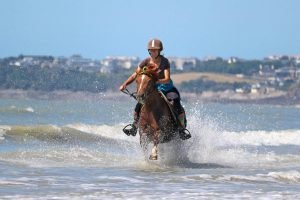When it comes to horseback riding on the beach, choosing the right attire is crucial for both comfort and safety. Riding along the shore is a unique experience, blending the thrill of horseback riding with the serene beauty of the ocean. To ensure you fully enjoy this experience, it’s important to dress appropriately. This guide will walk you through the essential clothing and gear needed for a beach horseback riding adventure.
1. Riding Helmets: Safety First
Safety should always be your top priority, and wearing a helmet is non-negotiable. For beach rides, choose a lightweight, ventilated helmet that provides comfort and protection under the sun. Make sure the helmet fits snugly and is properly certified for horseback riding.
2. UV-Protective Clothing: Shielding from the Sun
Beach rides mean prolonged exposure to the sun. Opt for long-sleeved shirts and pants made from UV-protective fabric. These clothes not only shield you from harmful UV rays but also help prevent sunburn. For a more equestrian-specific look, consider wearing a riding shirt and breeches with UV protection.
3. Comfortable Bottoms: Breeches or Jodhpurs
While jeans might seem like a good option, they can cause discomfort due to seams and stiffness. Instead, go for breeches or jodhpurs. These riding-specific pants offer flexibility and comfort, preventing chafing and allowing for better movement. Look for breeches with moisture-wicking properties to stay cool and dry.
4. Footwear: Riding Boots or Closed-Toe Shoes
Proper footwear is essential for both safety and comfort. While traditional riding boots are ideal, you can also opt for comfortable, closed-toe shoes with a small heel. This heel prevents your foot from slipping through the stirrup. Avoid wearing sandals or flip-flops as they offer no protection and can be dangerous.
5. Light Layers: Adapting to Changing Conditions
Even on the beach, weather conditions can change quickly. It’s a good idea to wear or bring light layers that you can easily put on or take off. A lightweight, waterproof jacket can be a lifesaver in case of unexpected rain or wind.
6. Gloves: Grip and Comfort
Riding gloves aren’t just for cold weather. They protect your hands from blisters and provide a better grip on the reins, especially useful if your hands get sweaty. Choose lightweight, breathable gloves to keep your hands cool and comfortable.
7. Sunglasses: Protecting Your Eyes
Sunglasses are important for beach riding to protect your eyes from the glare of the sun and sand. Opt for a pair with UV protection and a secure fit so they don’t fall off while riding. Polarized lenses are a great choice as they reduce glare and improve visibility.
8. Rash Guards: Versatile Protection for Riders
For those who prefer a more athletic look, consider wearing a rash guard. Originally designed for surfers, rash guards are perfect for beach riding due to their quick-drying and UV-protective properties. They provide a snug fit, ensuring comfort and ease of movement while riding. Moreover, they come in various designs and colors, allowing you to add a personal touch to your riding attire.
9. Breeches with Specialized Fabrics
Advancements in fabric technology have led to breeches that are not only comfortable but also practical for beach environments. Look for breeches made with lightweight, breathable materials that offer quick-drying capabilities. Some breeches are designed with a water-resistant finish, ideal for protecting against splashes or unexpected waves. These fabrics also help in keeping the sand off, making your ride more pleasant.
10. Appropriate Undergarments: The Unsung Heroes
Undergarments may not be visible, but they play a crucial role in your comfort. Opt for seamless, moisture-wicking underwear and sports bras that provide support without causing discomfort. Avoid cotton as it retains moisture; instead, go for synthetic blends that keep you dry and comfortable.
11. Hat or Visor: Extra Sun Protection
In addition to a helmet, consider wearing a hat or visor for added sun protection. A hat with a brim can shield your face from the sun, reducing glare and preventing sunburn. If you choose to wear a hat, ensure it fits comfortably under your helmet.
12. Neck Gaiter or Scarf: Versatile Accessory
A neck gaiter or light scarf can be a versatile addition to your beach riding attire. It can protect your neck from sunburn, and you can pull it up to shield your face from sand and wind. Choose a breathable, moisture-wicking fabric for maximum comfort.
13. Choosing the Right Socks: Comfort in Every Step
The right socks can make a significant difference in your riding experience. Look for thin, breathable socks that wick away moisture. Avoid thick, cotton socks as they can cause overheating and discomfort. Some riding socks are designed with extra padding in key areas for comfort and blister prevention.
14. Hydration and Snacks: Essential for Longer Rides
Hydration is key, especially on sunny beach rides. Bring a reusable water bottle, and if possible, pack a small, lightweight backpack with water and snacks. Choose energy-boosting snacks like nuts or energy bars to keep you fueled during your ride.
15. After-Ride Attire: Planning for Post-Ride Comfort
Once your ride is over, you might want to change into something more comfortable, especially if you plan to explore the area or relax on the beach. Pack a change of clothes, preferably something light and airy, to help you transition comfortably from your ride to your next activity.
Conclusion: The Right Attire Makes All the Difference
Dressing appropriately for a horseback ride on the beach is about balancing safety, comfort, and personal style. By choosing the right gear, you can ensure a more enjoyable and memorable riding experience. Remember, the best attire is the one that makes you feel confident and comfortable, allowing you to fully immerse yourself in the beauty and excitement of beach horseback riding.

